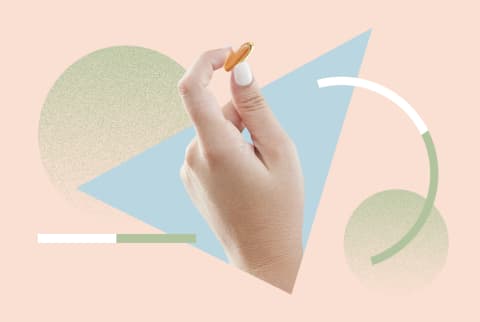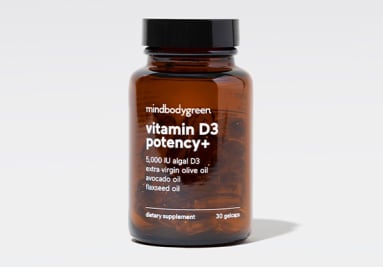Are You Actually Taking Enough Vitamin D? Experts Explain How To Make Sure


In our humble opinion, vitamin D is finally getting the credit it deserves. After all, it's one of the most well-documented players out there for immune support, bone health, muscle function, and more.* And considering vitamin D is one of the most common nutrient gaps1 in the U.S., this hurl into the spotlight feels well deserved—and, honestly, long overdue.
To achieve healthy vitamin D status (i.e., vitamin D sufficiency), though, you might head over to the supplements aisle, as ramping up levels through food alone generally doesn't cut it (more on that later).* Thing is, many vitamin D products on the market contain sub-efficacious doses. As a result, even if you've made it your personal mission to optimize your vitamin D levels, you might be struggling to move the needle.
As mbg's director of scientific affairs and in-house nutritionist Ashley Jordan Ferira, Ph.D., RDN, puts it, "This suboptimal dosing is a sneaky (and pervasive) issue in the vitamin D supplement world. It's about time somebody stood up and pointed it out."
In other words, it's not you—but it might be your supplement. Don't worry, though. Luckily, that's an easy fix.
Most people don't get enough vitamin D.
Ready for some stats? Sufficient vitamin D levels—which are measured via blood work using the biomarker total 25-hydroxyvitamin D [or 25(OH)D, for short]—are considered to be greater than 30 ng/mL2.
To consistently exceed this mark (remember, 30 is the starting point, not the goal), research shows you need a minimum of 3,000 IU of vitamin D3 every day.* Ferira explains why: "Clinical research3 demonstrates that 1,000 IU of vitamin D3 daily raises your 25(OH)D levels by about 10 ng/mL, so 3,000 IU roughly gets you to 30 ng/mL. That's the math. Please note that this pharmacokinetics science-backed rule-of-thumb applies to adults with a healthy weight, while much higher vitamin D dosing is needed in those with overweight or obesity2."*
Unfortunately, 931 to 100% of the U.S. population fails to consume even just 400 IU of vitamin D per day through food. That's right, 400 IU. Given that stat, it's no real surprise that 41% of adults in the U.S. are considered clinically insufficient4 in vitamin D (and that considers all inputs from sun, food, beverages, and supplements!)
Sad but true: While you can find vitamin D in small amounts in a handful of foods5, food alone simply is not enough to maintain healthy vitamin D status for life. Not to mention, "factors such as age, weight, disease state, and genetics" can influence vitamin D absorption in the GI tract, says registered dietitian nutritionist and mbg Collective member Maya Feller, M.S., R.D., CDN. Meaning, you might not even be absorbing all of the D you do consume through food.
And many vitamin D supplements don't even make a dent.
To ramp up your vitamin D status, you might turn to a targeted supplement.* (A stellar plan of action, we'd say.) But here's the thing: The amount of vitamin D found in many multivitamins—and even stand-alone vitamin D supplements—isn't enough to make a notable difference.
See, that 30 ng/mL 25(OH)D bloodwork value we mentioned is the cutoff for vitamin D insufficiency and deficiency. As mbg's Ferira shares on the mindbodygreen podcast: "This is not a goal to aim for but rather a minimum to avoid." This means that taking 3,000 IU of vitamin D per day is wholly inadequate for most adults.
Translation? Sure, you can hover around 30 ng/mL to avoid true vitamin D deficiency2, but to reach clinically sufficient levels (consistently for life), you actually need more than 30 ng/mL2. That's why Ferira (along with other trusted nutrition and medical experts) believe that greater than or equal to 50 ng/ml is the true goal for vitamin D sufficiency.
Unfortunately, though, most vitamin D-containing supplements simply can't help you meet that benchmark.
Of course, "smaller doses do provide a little more flexibility for people who may need less [vitamin D] at different times, or for those who take a few different supplements that contain vitamin D," notes registered dietitian Jess Cording, M.S., R.D., CDN.
Ferira expounds further: "For example, a multi-ingredient immune or bone health complex or a multivitamin may contain 1,000 IU or 2,000 IU of vitamin D3, and that's great. You might also find a cute dose of vitamin D3 in children's supplements and most calcium supplements to enhance that mineral's absorption too, which is also fine."
But she goes on to say that, "when it comes to a stand-alone vitamin D3 supplement, anything less than 3,000 IU is simply not helpful to the consumer."* Some supplement companies offer less-than-efficacious doses for vitamin D supplements (e.g., 400 IU, 600 IU, 1,000 IU, 2,000 IU) and assume the consumer will simply take more based on their needs. Ferira says, "I think it's time for companies to stop assuming and do the right thing here."
What to do about it.
This all leaves you in a bit of a pickle, now, doesn't it? To make a long, scientific story short, Ferira recommends you find a formula that helps you achieve and maintain optimal vitamin D levels rather than one that merely helps you meet the minimum.*
Ferira says, "Why offer consumers a dose that will barely flirt with the minimum cutoff for sufficiency? Whether poor logic or design, I think companies should stop selling suboptimal doses of vitamin D3 and simply offer up science-backed doses of this critically important nutrient to customers."
Enter mindbodygreen's vitamin D3 potency+: A targeted dose of 5,000 IU to help you get to (and stay) above that 50+ ng/mL threshold (and in just one gelcap, might we add). It contains vitamin D3 sustainably sourced from organic algae, paired with organic oils (flaxseed, avocado, and extra-virgin olive oils, to be exact) to enhance the absorption of vitamin D and provide an added bonus thanks to the antioxidant and anti-inflammatory properties of the omega-3 and omega-9 fatty acids in those oils.*
It's truly a one-of-a-kind vitamin D supplement, formulated specifically (and with love and science) to be your vitamin D solution for life.*
The takeaway.
Vitamin D gaps are rampant, but given the small amounts of this nutrient in foods (and most supplements), optimizing our status has long been easier said than done. Since most of us need a minimum of 3,000 IU per day, mindbodygreen created vitamin D3 potency+, which delivers 5,000 IU of high-quality D3 to help you aim for (and hit) that 50+ ng/mL mark of vitamin D sufficiency. With a high-potency, premium supplement like this one in your routine, you can finally reach and maintain healthy vitamin D status for life.*

Jamie Schneider is the Beauty Editor at mindbodygreen. She has a B.A. in Organizational Studies and English from the University of Michigan, and her work has appeared in Coveteur, The Chill Times, and more. In her role at mbg, she reports on everything from the top beauty industry trends, to the gut-skin connection and the microbiome, to the latest expert makeup hacks. She currently lives in Brooklyn, New York.

